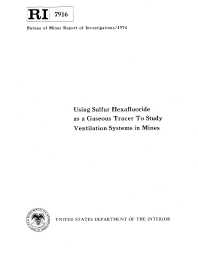Mining Publication: Using Sulfur Hexafluoride as a Gaseous Tracer to Study Ventilation Systems in Mines
Original creation date: January 1974
The Bureau of Mines found sulfur hexafluoride (SF6), released from a lecture bottle, to be an ideal gaseous tracer for studying mine ventilation systems. Air samples were collected in glass syringes and analyzed by electron-capture gas chromatography. In these studies, the lower limit of detection was about 1 part per billion by volume (ppb) of SF6 per part of air. Experiments conducted in a Pennsylvania limestone mine showed this technique useful in evaluating the effectiveness of auxiliary fans, measuring low flow velocities, probing the air circulating near a working face region where ventilation appeared to be poor, and estimating volumetric flow rates in airways of large cross-sectional area and having low flow velocities. This technique was also used in a western vein-type metal mine to measure the amount of return air being recirculated into the intake air due to leakage through old stoped areas.
Authors: ED Thimons, RJ Bielicki, FN Kissell
Report of Investigations - January 1974
NIOSHTIC2 Number: 10000741
Source Pittsburgh, PA: U.S. Department of the Interior, Bureau of Mines, RI 7916, 1974 Jan; :1-22
See Also
- Development and Application of Reservoir Models and Artificial Neural Networks for Optimizing Ventilation Air Requirements in Development Mining of Coal Seams
- Dust Considerations When Using Belt Entry Air to Ventilate Work Areas
- Evaluating Ventilation Parameters of Three Coal Mine Gobs
- Evaluation of the Relative Importance of Coalbed Reservoir Parameters for Prediction of Methane Inflow Rates During Mining of Longwall Development Entries
- Face Ventilation Measurement with Sulfur Hexafluoride (SF6)
- Modeling and Prediction of Ventilation Methane Emissions of U.S. Longwall Mines Using Supervised Artificial Neural Networks
- Strengthening Existing 20-psi Mine Ventilation Seals With Carbon Fiber-Reinforced Polymer Reinforcement
- Sulfur Hexafluoride as a Mine Ventilation Research Tool - Recent Field Applications
- Three Coal Mine Ventilation Studies Using Sulfur Hexafluoride Tracer Gas
- Use of Vertical Boreholes for Assisting Ventilation of Longwall Gob Areas
- Content source: National Institute for Occupational Safety and Health, Mining Program


 ShareCompartir
ShareCompartir
